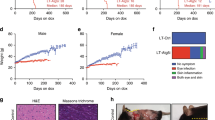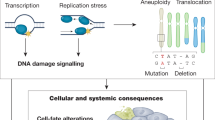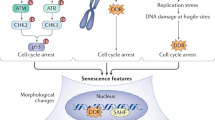Abstract
The tumour-suppressor pathway formed by the alternative reading frame protein of the Cdkn2a locus (Arf) and by p53 (also called Trp53) plays a central part in the detection and elimination of cellular damage, and this constitutes the basis of its potent cancer protection activity1,2. Similar to cancer, ageing also results from the accumulation of damage and, therefore, we have reasoned that Arf/p53 could have anti-ageing activity by alleviating the load of age-associated damage. Here we show that genetically manipulated mice with increased, but otherwise normally regulated, levels of Arf and p53 present strong cancer resistance and have decreased levels of ageing-associated damage. These observations extend the protective role of Arf/p53 to ageing, revealing a previously unknown anti-ageing mechanism and providing a rationale for the co-evolution of cancer resistance and longevity.
This is a preview of subscription content, access via your institution
Access options
Subscribe to this journal
Receive 51 print issues and online access
$199.00 per year
only $3.90 per issue
Buy this article
- Purchase on Springer Link
- Instant access to full article PDF
Prices may be subject to local taxes which are calculated during checkout




Similar content being viewed by others
References
Harris, S. L. & Levine, A. J. The p53 pathway: positive and negative feedback loops. Oncogene 24, 2899–2908 (2005)
Lowe, S. W., Cepero, E. & Evan, G. Intrinsic tumour suppression. Nature 432, 307–315 (2004)
Pinkston, J. M., Garigan, D., Hansen, M. & Kenyon, C. Mutations that increase the life span of C. elegans inhibit tumor growth. Science 313, 971–975 (2006)
Garcia-Cao, I. et al. ‘Super p53’ mice exhibit enhanced DNA damage response, are tumor resistant and age normally. EMBO J. 21, 6225–6235 (2002)
Matheu, A. et al. Increased gene dosage of Ink4a/Arf results in cancer resistance and normal aging. Genes Dev. 18, 2736–2746 (2004)
Garcia-Cao, I. et al. Increased p53 activity does not accelerate telomere-driven ageing. EMBO Rep. 7, 546–552 (2006)
Mendrysa, S. M. et al. Tumor suppression and normal aging in mice with constitutively high p53 activity. Genes Dev. 20, 16–21 (2006)
Tyner, S. D. et al. p53 mutant mice that display early ageing-associated phenotypes. Nature 415, 45–53 (2002)
Maier, B. et al. Modulation of mammalian life span by the short isoform of p53. Genes Dev. 18, 306–319 (2004)
Forster, M. J., Morris, P. & Sohal, R. S. Genotype and age influence the effect of caloric intake on mortality in mice. FASEB J. 17, 690–692 (2003)
Liang, H. et al. Genetic mouse models of extended lifespan. Exp. Gerontol. 38, 1353–1364 (2003)
Coschigano, K. T. et al. Deletion, but not antagonism, of the mouse growth hormone receptor results in severely decreased body weights, insulin, and insulin-like growth factor I levels and increased life span. Endocrinology 144, 3799–3810 (2003)
Ingram, D. K. & Reynolds, M. A. Assessing the predictive validity of psychomotor tests as measures of biological age in mice. Exp. Aging Res. 12, 155–162 (1986)
Sedelnikova, O. A. et al. Senescing human cells and ageing mice accumulate DNA lesions with unrepairable double-strand breaks. Nature Cell Biol. 6, 168–170 (2004)
Herbig, U., Ferreira, M., Condel, L., Carey, D. & Sedivy, J. M. Cellular senescence in aging primates. Science 311, 1257 (2006)
Janzen, V. et al. Stem-cell ageing modified by the cyclin-dependent kinase inhibitor p16INK4a. Nature 443, 421–426 (2006)
Krishnamurthy, J. et al. p16INK4a induces an age-dependent decline in islet regenerative potential. Nature 443, 453–457 (2006)
Molofsky, A. V. et al. Increasing p16INK4a expression decreases forebrain progenitors and neurogenesis during ageing. Nature 443, 448–452 (2006)
Schriner, S. E. et al. Extension of murine life span by overexpression of catalase targeted to mitochondria. Science 308, 1909–1911 (2005)
Vousden, K. H. & Lane, D. P. p53 in health and disease. Nature Rev. Mol. Cell Biol. 8, 275–283 (2007)
Velasco-Miguel, S. et al. PA26, a novel target of the p53 tumor suppressor and member of the GADD family of DNA damage and growth arrest inducible genes. Oncogene 18, 127–137 (1999)
Budanov, A. V. et al. Identification of a novel stress-responsive gene Hi95 involved in regulation of cell viability. Oncogene 21, 6017–6031 (2002)
Sablina, A. A. et al. The antioxidant function of the p53 tumor suppressor. Nature Med. 11, 1306–1313 (2005)
Neumann, C. A. et al. Essential role for the peroxiredoxin Prdx1 in erythrocyte antioxidant defence and tumour suppression. Nature 424, 561–565 (2003)
Wood, Z. A., Schroder, E., Robin Harris, J. & Poole, L. B. Structure, mechanism and regulation of peroxiredoxins. Trends Biochem. Sci. 28, 32–40 (2003)
Budanov, A. V., Sablina, A. A., Feinstein, E., Koonin, E. V. & Chumakov, P. M. Regeneration of peroxiredoxins by p53-regulated sestrins, homologs of bacterial AhpD. Science 304, 596–600 (2004)
Agarwal, S. & Sohal, R. S. Relationship between susceptibility to protein oxidation, aging, and maximum life span potential of different species. Exp. Gerontol. 31, 365–372 (1996)
Kapahi, P., Boulton, M. E. & Kirkwood, T. B. Positive correlation between mammalian life span and cellular resistance to stress. Free Radic. Biol. Med. 26, 495–500 (1999)
Yamamoto, M. et al. Regulation of oxidative stress by the anti-aging hormone klotho. J. Biol. Chem. 280, 38029–38034 (2005)
Varela, I. et al. Accelerated ageing in mice deficient in Zmpste24 protease is linked to p53 signalling activation. Nature 437, 564–568 (2005)
Pantoja, C. & Serrano, M. Murine fibroblasts lacking p21 undergo senescence and are resistant to transformation by oncogenic Ras. Oncogene 18, 4974–4982 (1999)
Palmero, I. & Serrano, M. Induction of senescence by oncogenic Ras. Methods Enzymol. 333, 247–256 (2001)
Wexler, H. & Rosenberg, S. A. Pulmonary metastases from autochthonous 3-methylcholanthrene-induced murine tumors. J. Natl Cancer Inst. 63, 1393–1395 (1979)
Matheu, A., Klatt, P. & Serrano, M. Regulation of the INK4a/ARF locus by histone deacetylase inhibitors. J. Biol. Chem. 280, 42433–42441 (2005)
Yuan, J. S., Reed, A., Chen, F. & Stewart, C. N. Jr Statistical analysis of real-time PCR data. BMC Bioinformatics 7, 85 (2006)
Asensi, M., Sastre, J., Pallardo, F. V., Estrela, J. M. & Vina, J. Determination of oxidized glutathione in blood: high-performance liquid chromatography. Methods Enzymol. 234, 367–371 (1994)
Wong, S. H. et al. Lipoperoxides in plasma as measured by liquid-chromatographic separation of malondialdehyde-thiobarbituric acid adduct. Clin. Chem. 33, 214–220 (1987)
Gonzalez-Suarez, E., Samper, E., Flores, J. M. & Blasco, M. A. Telomerase-deficient mice with short telomeres are resistant to skin tumorigenesis. Nature Genet. 26, 114–117 (2000)
Acknowledgements
We thank M. Muñoz for mouse colony management and animal care and E. Santos for mouse genotyping. A. Matheu was funded by a predoctoral fellowship from the Spanish Ministry of Education and Science (MEC); A. Maraver is funded by the Juan de la Cierva Program of the MEC; and I.F. is funded by the Ramon y Cajal Program of the MEC. This work has been funded by the MEC (M.S. and M.A.B.) and the European Union (M.S. and M.A.B.). M.A.B. is a recipient of the Josef Steiner Cancer Research Award 2003.
Author Contributions A. Matheu and A. Maraver contributed equally to this work; A. Matheu, A. Maraver, I.F., I.G.-C., C.B. and J.M.F. performed experimental work; P.K. analysed data and assisted in editing the paper; M.S. wrote the paper; J.V. and M.A.B. co-directed research; and M.S. designed research and directed the project.
Author information
Authors and Affiliations
Corresponding author
Ethics declarations
Competing interests
Reprints and permissions information is available at www.nature.com/reprints. The authors declare no competing financial interests.
Supplementary information
Supplementary Information
This file contains Supplementary Tables S1-S2 and Supplementary Figures S1-S15 with Legends. The file was corrected on 20 July 2007 (PDF 1523 kb)
Rights and permissions
About this article
Cite this article
Matheu, A., Maraver, A., Klatt, P. et al. Delayed ageing through damage protection by the Arf/p53 pathway. Nature 448, 375–379 (2007). https://doi.org/10.1038/nature05949
Received:
Accepted:
Issue Date:
DOI: https://doi.org/10.1038/nature05949
This article is cited by
-
Role of sestrins in metabolic and aging-related diseases
Biogerontology (2024)
-
Targeting the “hallmarks of aging” to slow aging and treat age-related disease: fact or fiction?
Molecular Psychiatry (2023)
-
Dynamics of redox signaling in aging via autophagy, inflammation, and senescence
Biogerontology (2023)
-
MYD88 signals induce tumour-initiating cell generation through the NF-κB-HIF-1α activation cascade
Scientific Reports (2021)
-
Single loss of a Trp53 allele triggers an increased oxidative, DNA damage and cytokine inflammatory responses through deregulation of IκBα expression
Cell Death & Disease (2021)
Comments
By submitting a comment you agree to abide by our Terms and Community Guidelines. If you find something abusive or that does not comply with our terms or guidelines please flag it as inappropriate.



